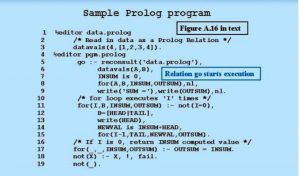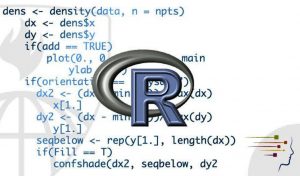Programming Languages for Artificial Intelligence: Artificial Intelligence has now become a key part of our daily lives, thanks to all of the benefits it provides, as well as how simple and easy it has made things for us. Users everywhere benefit from AI programming’s amazing productivity and quality-of-life improvements. As much as smart speakers and search engines generate headlines, they are only a small part of the vast AI tech that is currently at work.
However, you might wonder, what exactly is AI?
Artificial intelligence (abbreviated as AI) fundamentally refers to the machine-based simulation of human thinking: intelligence. In simpler terms, AI is a technology that uses programming approaches to collect and learn from massive amounts of data.
In recent years, AI has come a long way in terms of supporting businesses in growing and fulfilling their full potential. Without substantial advancements in the programming languages that underlie AI, these advancements would not have been possible.
Presently, the demand for efficient and talented programmers and engineers, as well as the variety of programming languages available, has grown in tandem with the rise of AI. While there are a variety of programming languages to get you started with AI creation, no single programming language is a one-stop-shop for AI programming because varied objectives need a distinct method for each project. As a result, Individuals interested in the world in AI development may find it difficult to choose the best programming language to learn and use.
In this article, we shall explore some of the AI-related programming languages you can learn. But before then, let look at the meaning of AI development.
Recommended: Price For Lawyer’s Wig And Gown In Nigeria 2024
What Is AI Development?
Artificial intelligence is a branch of computer science that deals with intelligent devices and systems. The goal of programming in AI is to create computers that can think like humans do by giving them the ability to learn from experience, so that they can solve problems creatively.
The programming of AI enables machines to carry out tasks that normally require human intelligence, and its software is used for a variety of applications that mimic human behavior, such as: language translation and problem-solving.
Roles of AI Development
Artificial Intelligence (AI) plays a huge role in many aspects of our lives: from autonomous vehicles to personalized shopping. Some of these roles include: doctors use AI to predict diagnoses , life expectancy, and treatment outcomes (in healthcare).
AI is used for fraud detection (in banking), it is used to predict cyber attacks and other national security vulnerabilities (in military and defense).
Recommended: Programming languages used for Cyber Security
Top 11 Best AI Programming Languages To Learn in 2024
1. Python: Right now, Python can be thought of as the forerunner of all other languages. Python is arguably the most popular and effective programming language for developing Artificial Intelligence/Machine Language and NLP applications. It is also ideal for platform-agnostic programming and deep learning.
A powerful programming language, Python code is straightforward, concise, and understandable, which makes coding more enjoyable because hundreds of AI/ML algorithms may be run with the help of a large library.
Python is a fantastic choice for Machine Learning procedures because of its simple syntax and even if you are new to AI programming, you can utilize it. According to a Forbes article, “Although Python has proven to be effective in a variety of other areas, such as making websites and creating scripts for DevOps, it is with AI/ML where the language has shone“.
Python is the language of choice for custom AI development because it offers ready-to-use libraries (such as TensorFlow, SciKit-Learn, and others), supports object-oriented programming, has a higher development speed and allows you to test algorithms without having to run them.
The best part is that Python can easily be used with other languages, such as JAVA, to increase versatility even more. Python is utilized by more than half of the world’s developers for AI development since it can also be used for soft computing, web programming, and ethical hacking. Python is, as a result, one of the best programming languages to learn for AI.
2. C++: C++ is a computer language that extends the C programming language and can be used to create neural networks. The speed of C++ is the most significant advantage, as AI development requires sophisticated computations, which this language can speed up. It’s ideal for time-sensitive artificial intelligence initiatives and can be applied to statistical AI approaches like neural networks.
It has a low-level memory control function and is capable of running asset-intensive, performance-critical applications etc. Although C++ has a complex syntax, it is less expensive than competitor languages such as Java. C++ is a programming language that can be employed in AI for search engine optimization and ranking.
Recommended: List of programming languages and their uses
3. Java: Java is a popular programming language with a plethora of open-source packages. Because it is user-friendly and provides an autonomous platform, Java is an excellent choice for AI development.
This is a flexible and standard programming language that allows for faster code debugging, scalability, and support for large organizations, as well as the presentation of graphical data. Java is simple to learn, adaptable, and its Virtual Machine Technology allows AI languages to be built on a variety of platforms.
4. Lisp: John McCarthy created LISP, or list processing, in 1958. It is a programming language that can be used to develop artificial intelligence. LISP is adaptable and flexible, making it ideal for machine learning. LISP is well-known for its quick prototyping and dynamic object creation. Although, because the codes are more difficult to learn and it lacks decent libraries, LISP is no longer widely utilized.

Features of Lisp that make it one of the best options for AI include:
a. Rapid Prototyping
b. Dynamic Object Creation
c. Garbage Collection
d. Flexibility
Also see: Most profitable skills to learn online 2023
5. Prolog: Prolog, or logical programming, is one of the oldest programming languages. It is a powerful framework that works with three elements: facts, rules, and goals. A developer must define all three elements, after which Prolog develops relationships between them to arrive at a certain conclusion through the analysis of facts and rules.

Algorithms are implemented using logical inferences and searches, and this language is ideal for constructing AI systems because the solutions are logical rather than relying on pre-existing statements. Prolog is ideal for designing chatbots, voice assistants, and Graphical User Interface(GUI).
Benefits of Using Prolog for AI
a. It uses a versatile and powerful framework for theorem proving, non-numerical programming, natural language processing, and AI in general.
b. It’s a formal logic declarative language. Its pre-designed search engine, nondeterminism, backtracking mechanism, recursive nature, high-level abstraction, and pattern matching are all valued by AI developers.
Recommended: Best budget laptops for programming students and programmers
6. R: It’s a free and open-source programming language for statistical and scientific computing. R programming language is useful for creating interactive visuals and other complex visualizations. Its architecture can handle a wide range of data processing jobs, from simple linear regressions to complex three-dimensional simulations. Anyone may utilize the R programming language.

R was created as a programming language to handle everything from statistical computation to machine learning. R has object-oriented programming, a high level of extensibility, memory-efficient non-stop processing, a large user base, and is commonly used for forecasting.
Features of R that make it a good fit for AI programming among developers include:
a. R’s core capability to crunch large numbers puts it in a stronger position than Python’s comparatively crude NumPy library.
b. You can use R to work on a variety of programming paradigms, including functional programming, vectorial computation, and object-oriented programming.
c. Many statistical approaches, import/export capabilities, tools, and graphical devices, among other things, can be added to R’s capabilities through user-created packages. This promotes language’s development and makes it a popular choice among data scientists and analysts. It comes with built-in data modelling and graphics support, allowing programmers to create important deep learning models with less effort.
7. Haskell: Haskell is a completely functional programming language, which implies that all expressions are evaluated to generate a single value. Haskell relies largely on recursion to write code because it lacks variables, but it does feature some mutable types, such as lists and arrays.

It makes Haskell perfect for creating sophisticated algorithms with multiple phases leading to a final conclusion. The syntax can be confusing because it organizes code into lines with semicolons at the end of each line rather than indentation.
The type system in Haskell is one of its most appealing aspects. You can’t save anything in a variable or provide nothing as an argument because it has no null value.
Benefits of Haskell for AI programming includes:
- Strong abstraction capabilities
- Haskell has a powerful type system that helps you avoid a variety of errors in your code.
- Code reusability
- Easy to understand: While other languages make writing concise code more difficult, Haskell makes it relatively simple. Because of its conciseness, it also allows you to work on numerous tasks at the same time. As a result, it is appropriate for projects involving enormous amounts of data.
- The speed of Haskell is a huge advantage. Because of its simplicity, Haskell applications frequently execute faster than programs written in other programming languages.
Also see: How to become a successful business entrepreneur
8. Javascript: JavaScript is a commonly used artificial intelligence programming language that may be used to create everything from chatbots to computer vision. Because of its flexibility and large developer community, JavaScript has swiftly become one of AI’s most popular languages.

Since JavaScript was created in 1995, many human-like behaviours have been written using it, such as facial recognition and art generation programs. As businesses continue to move away from old-fashioned legacy systems, JavaScript will remain an essential skill for anyone looking to gain insights into artificial intelligence.
Benefits of Using JavaScript for AI
Because of its considerable versatility, JS may be used with a wide range of operating systems, browsers, and virtual machines.
It is not necessary to port it from one system to another because many have similar architecture.
It’s also one of the only languages where there’s a decent possibility you’ll be able to use it in any domain you want.
Because it’s web-based (and browser-based), the code is simple; there aren’t many technical requirements.
9. Julia: Julia is well-positioned to capitalize on the growing interest in artificial intelligence. The language was created from the ground up with numerical performance in mind by Jeff Bezanson, Stefan Karpinski, Viral B. Shah, and his team, and it runs on nearly every operating system.
It’s also quite simple to learn because it employs many of the same coding ideas you’re already familiar with, such as loops and conditional expressions.

Benefits of using Julia for AI
- It’s a high-level, high-performance programming language created with scientific computing in mind.
- Julia’s syntax is simple and straightforward, so you can concentrate on solving your problem rather than writing new code.
- You may save time and produce cleaner, faster code with fewer errors by using Julia.
- Julia’s major advantage is that it’s free and open-source, which means anyone can look at its code.
10. Scala: Scala provides a better approach for creating intelligent software using the Java Virtual Machine (JVM) environment. It’s compatible with Java and JavaScript, and it makes coding easier, faster, and more efficient.

Scala’s efforts to impress programmers are paying off thanks to its powerful features, such as high-performance functions, customizable interfaces, pattern matching, and browser tools. It’s now widely regarded as one of the best languages for AI research.
Another benefit to remember is the Scaladex, which is an index of all available Scala libraries and their resources.
Recommended: Richest woman in Africa
11. Golang: This programming language is designed to provide a balance between performance and simplicity. Although it was not originally created for the development of AI, it has some features that make it a good choice for building models of machine learning and other applications for AI. However, one of the key strengths of Go (Golang) is its excellent support for concurrent programming. It lets developers write highly concurrent and parallel programs quickly. That makes it well-suited for developing application for large-scale ML that require processing large amounts of data in parallel.

Again, this programming language has speed. It is a compiled language that produces highly optimized binaries faster than interpreted languages (such as Python). That makes it ideal for developing high-performance applications for AI such as: systems for speech recognition and real-time image. The standard library of this programming language includes packages for working with data formats such as: CSV, XML, and JSON. These make working with data from various sources easy. Again, this programming language strongly focuses on readability and maintainability of code. This makes it easy for teams to collaborate on projects of AI. Simple syntax and a straightforward approach to programming can reduce errors and make code easier to understand and maintain over time. So, it has a growing number of AI-related libraries. They include: packages for machine learning (GoLearn), natural language processing (GoNLP), and computer vision (GoCV). However, a TensorFlow library is available for Go that allows developers to build and deploy models of machine learning.
Gorgonia is a library deep learning in Goland. It provides a set of composable building blocks for defining and training models of machine learning. Again, Fuego is a library that provides support for fuzzy logic in this programming language. Fuzzy logic is a technique (used in AI) that allows for reasoning with uncertain or imprecise data. GoML is a library that provides a set of algorithms for machine-learning that can be used for classification, clustering, and regression. Again, Gobot is a library for development of the CV robotics in this programming language. It supports different platforms for hardware such as: Raspberry Pi and Arduino, and can be used for the development of AI applications that interact with the physical world.
Recommended: Best websites to learn web and application programming for free
Conclusion
Artificial intelligence is an integral element of the future economy. Programming languages are the backbones of AI development initiatives because they allow software engineers to design creative AI solutions without having to acquire the highly specialized language that scientists use to communicate with one another. Therefore, learning and understanding these programming languages may be beneficial to those interested in discovering more about AI.

Edeh Samuel Chukwuemeka, ACMC, is a lawyer and a certified mediator/conciliator in Nigeria. He is also a developer with knowledge in various programming languages. Samuel is determined to leverage his skills in technology, SEO, and legal practice to revolutionize the legal profession worldwide by creating web and mobile applications that simplify legal research. Sam is also passionate about educating and providing valuable information to people.